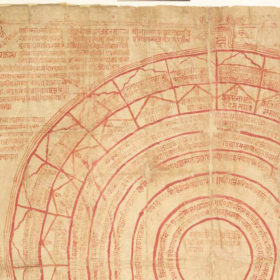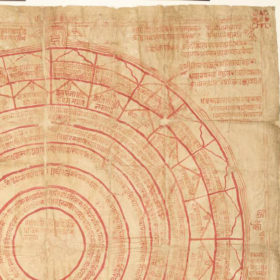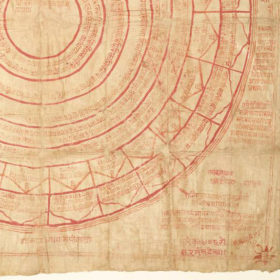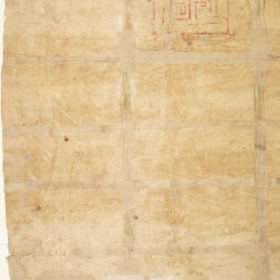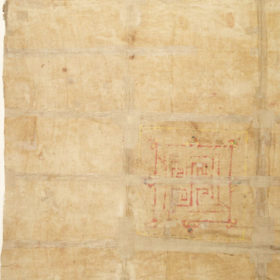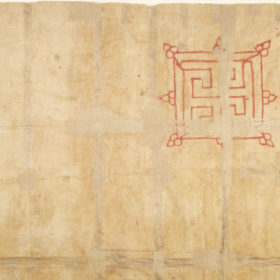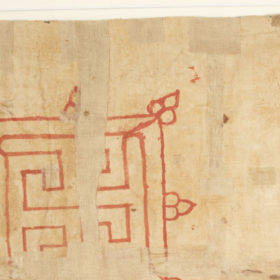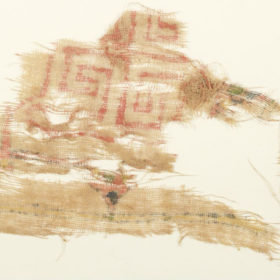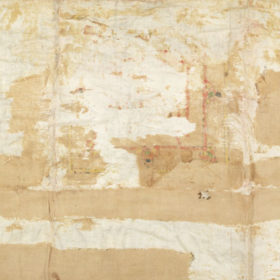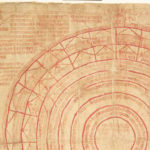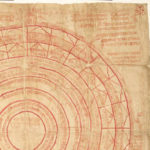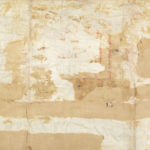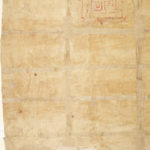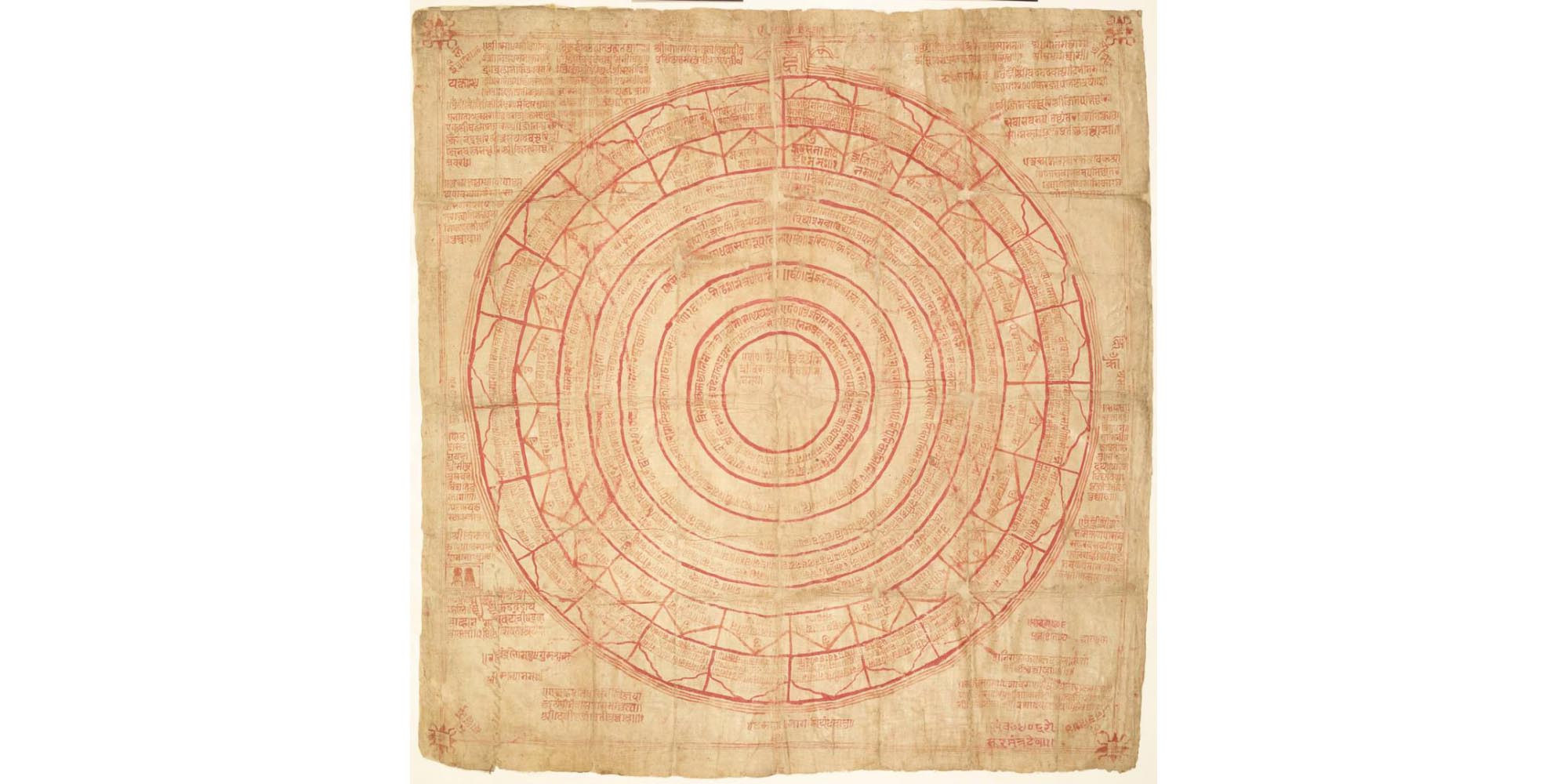
Background
A sūri-mantra-paṭa is a mystical diagram on cloth, like here, or on paper, which features formulas of homage and sacred syllables – mantras. It is thus a kind of maṇḍala or yantra, which is frequently used in worship and meditation among both ascetics and lay people.
Monks of the Śvetāmbara monastic orders use sūri-mantra-paṭas when they reach the higher ranks of religious hierarchy. The yantra gets its name from the highest grade of male mendicant, which is sūri, but it can also be used among lower monastic levels. More generally, worshippers are inspired by the example of Indrabhūti Gautama or Gautama-svāmin, the foremost disciple of Mahāvīra, the 24th Jina. He is often shown at the centre of the diagram, although not here.
The date on this sūri-mantra-paṭa corresponds to 1449 CE, making it among the oldest known examples. All yantras include pictures and text but the muted colour scheme and chiefly textual appearance of this one contrasts sharply with modern sūri-mantra-paṭas, which are often brightly coloured and have little text.
Glossary
Description
Eight concentric circles contain phrases in small writing. The circles are surrounded by a lot of text, filling up most of the space within the square frame enclosing the circular shape. Above the circle are two eyes looking upwards, separated by a symbol. A pair of footprints can be seen on the left, towards the bottom, in the middle of text. Decorative emblems are at the four corners of the square. All the writing and symbols on the cloth are in red ink.
This is a sūri-mantra-paṭa – a type of yantra or mystical diagram – found among Śvetāmbara monastic orders. The magic and sacred syllable hrīṃ is at the top, in the middle, with an auspicious eye each side. The circles are similar to the depiction of continents and oceans in Jain cosmology while the writing in each one consists of lines of mantras written in Sanskrit or Prakrit.
Mantras
In the circle in the middle is the principal mantra, which is devoted to ‘Gotamasvāmin’, a respectful name for Indrabhūti Gautama, the main disciple of Mahāvīra, the 24th Jina. The second circle from the outside is dedicated to the 24 Jinas, whose names appear in individual boxes. The other circles contain mantras offering homage to:
- the different sorts of knowledge
- the various kinds of monks who have this knowledge
- terms or concepts of Jain belief
- the nine planets, in the lower part of the left side, continuing on the right side
- the four orders of Jain deities – Bhavanapati, Vyantara, Jyotiṣka and Vaimānika
- other groups of beings such as the Jinas' divine attendants, the yakṣas and yakṣīs
- the vidyā-devīs, who are associated with magical knowledge or powers
- assorted classes of demons, such as preta and piśāca.
Dispersed around the yantra are a few Sanskrit stanzas, which pay homage to deities, such as the one to Śrīdevī in the bottom-left part. In the middle of the right-hand side is a Prakrit stanza honouring Pārśvanātha or Lord Pārśva, the 23rd Jina.
Kharatara-gaccha sect
One phrase appears in several places on the yantra, referring to asmad-gaccha – ‘our gaccha’. The gaccha or sect is not named but the heads of the Kharatara-gaccha monastic order are listed in the top corners, making it clear that the yantra refers to this sect.
The list begins in the top left with the monk who is said to have founded the sect in the 11th century, Vardhamāna-sūri, who died in 1031 CE, and the monk who consolidated this order, Jineśvara-sūri.
Then come his disciples and successors:
- Jinacandra-sūri
- Abhayadeva-sūri
- Jinavallabha-sūri
- Jinadatta-sūri.
The list continues in the top right of the yantra, with the names of:
- Jinacandra-sūri, called 'Maṇidhārī', who was Jinadatta-sūri's successor
- Jinapati-sūri (1153–1222 CE).
The name Jinacandra-sūri appears also above the footprints – pādukās – on the lower left side of the maṇḍala. The footprints are accompanied by the phrase:
śrīJinacandrasūri-pādebhyaḥ sadā namo ‘stu //
may there always be homage to the feet of Jinacandrasūri
There are several heads of the Kharatara-gaccha with the name Jinacandra-sūri. But it is likely that the footprints and homage refer to the one listed in the top right, who is one of the Dādā-gurus. These are the major teachers of this monastic order, who largely owe their fame to their miraculous powers (see Babb 1996).
Date
In the middle of the right-hand portion is the phrase:
saṃvat 1506 pratiṣṭito ‘ya[m] ārādhaka
it was consecrated in the year 1506 of the Vikrama era. The worshipper is this
Corresponding to 1449 CE, this date makes this sūri-mantra-paṭa one of the oldest surviving examples, if it is authentic.
However, the name of the ārādhaka is missing, who is the person who would have worshipped this yantra. The absence of a name indicates that perhaps this mystical diagram was never used.
Modern label
At the very bottom of the lower-right corner is a label that was not written by the scribe who created the yantra.
It says:
//saṃvat 406 ro Sūramaṃtra ṭebā //1//
commentary on the sūrimantra of saṃvat 406
The word ṭebā is a variant of ṭabo, a Gujarati word that means 'commentary' or 'word-to-word paraphrase', while ro is the Rajasthani postposition meaning 'of'.
The date is strange but is probably meant to be (1)506, repeating the original date in the Vikrama era. It is likely that the label was written in the 19th century, when many Jain mantras and maṇḍalas changed hands, to identify the object.
- Source:
Royal Asiatic Society
- Shelfmark:
065.001
- Author:
unknown
- Date of creation:
1449
- Folio number:
not applicable
- Total number of folios:
1 large size
- Place of creation:
western India
- Language:
Prakrit and Sanskrit
- Medium:
gouache on cloth
- Size:
57.5 x 54 cm
- Copyright:
Royal Asiatic Society Images/RAS, London
- Image Copyright:
- +
- aAbhavya
- aAbhinandana
- aAbhiṣeka
- aĀcāra
- aĀcārāṅga-sūtra
- aĀcārya
- aAchalbhrata
- aAḍhāī-dvīpa
- aAdharma
- aAdho-loka
- aAdhyayana
- aAdvaita Vedānta
- aĀgama
- aAghātīya
- aAghātīya-karman
- aAgnibhuti
- aAgra
- aĀhāra
- aAhiṃsā
- aAhimsa Day
- aAjita
- aAjīva
- aAkampit
- aĀkāśa
- aAkbar the Great
- aAkṣaya-tṛtīyā
- aAlauddin Khalji
- aAlbert Einstein
- aAllah
- aAlms
- aĀlocanā
- aAloka-ākāśa
- aAmāri
- aAmbikā or Kūṣmāṇḍinī
- aAnagāra
- aAnanta
- aAnarthadaṇḍa
- aAnaśana
- aAnekānta-vāda
- aAṅga
- aAniconism
- aAnojjā
- aAntarāla
- aAntarāya-karma
- aAṇu
- aAṇu-vrata
- aAnukampā
- aAnuprekṣā
- aAnusvāra
- aApabhraṃśa
- aAparigraha
- aAra
- aĀrambha
- aĀrambhaja
- aĀratī
- aArdhamāgadhī Prākrit
- aArhaṃ
- aArhat
- aArśana-āvaraṇīya-karma
- aĀrta-dhyāna
- aĀryikā
- aĀryikā Jñānamati
- aĀśātanā
- aĀścarya
- aAscetic
- aAsceticism
- aAshram
- aAspiration
- aĀsrava
- aAṣṭa-maṅgala
- aAṣṭāpada
- aAstikāya
- aAstrolabe
- aAsura
- aAtheism
- aAticāra
- aAtiśayakṣetra
- aAtithisaṃvibhāgavrata
- aĀtma-vāda
- aĀtman
- aAuṃ
- aAurangzeb
- aAuspicious
- aAusterity
- aAvadhāna
- aAvadhi-jñāna
- aĀvaraṇī-yakarman
- aAvasarpiṇī
- aAvatāra
- aAvidyā
- aAxiom
- aĀyāga-paṭa
- aĀyambil
- aĀyu-karma
- aĀyurveda
- bBabur
- bBāhubali
- bBaladeva
- bBālāvabodha
- bBandha
- bBasadi
- bBazaar
- bBhadrankarvijay
- bBhagavant
- bBhaktāmara-stotra
- bBhakti
- bBhale
- bBharata
- bBhāṣā
- bBhāṣya
- bBhaṭṭāraka
- bBhāva
- bBhāva-pūjā
- bBhāvanā
- bBhavana-vāsin
- bBhavya
- bBhavyatva
- bBhaya
- bBhoga-bhūmi
- bBhogopabhoga
- bBodhi
- bBollywood
- bBrahmā
- bBrahma-deva
- bBrahmacārī
- bBrāhmaṇa
- bBraj Bhāṣā
- bBright fortnight
- bBritish Raj
- bBuddha
- bBuddhi-sagar
- bBuddhism
- bBuddhist
- cCaitya
- cCaityavāsin
- cCakravartin
- cCakreśvarī
- cCāmara
- cCandanā
- cCandragupta
- cCandraprabha
- cCanon
- cCāritra
- cCāritramohanīya-karman
- cCarũrī
- cCaste
- cCaturvidha-saṅgha
- cCaturviṃśati-stava
- cCāturyāma
- cCE
- cCelibacy
- cCha
- cChadmastha
- cChastity
- cCheda-sūtra
- cChristian
- cChristianity
- cClergy
- cCloning
- cColophon
- cCommentary
- cConch
- cConfession
- cCongregation
- cConsecration
- cCosmology
- cCremation
- cCrore
- cCult
- cCūrṇi
- dDādā-guru
- dDalit
- dDāna
- dDaṇḍa
- dDark fortnight
- dDarśana
- dDarśanamohanī-yakarman
- dDaśa-lakṣaṇa-parvan
- dDeity
- dDelhi Sultanate
- dDerāsar
- dDeśāvakāśika-vrata
- dDetachment
- dDevanāgarī
- dDevānandā
- dDevarddhi-gani
- dDevotee
- dDhamal
- dDhanuṣ
- dDhāra
- dDharma
- dDharma-dhyāna
- dDharma-sāgara
- dDharmastikaya
- dDhātakīkhaṇḍa
- dDholak
- dDhyāna
- dDiaspora
- dDig-vrata
- dDigambara
- dDīkṣā
- dDisciple
- dDīvālī
- dDivya-dhvani
- dDNA
- dDoctrine
- dDogma
- dDonor
- dDoṣa
- dDravya
- dDravya-pūjā
- dDrone
- dDuṣamā
- dDuṣamā-duṣamā
- dDuṣamā-suṣamā
- dDveṣa
- dDvīpa
- eEast India Company
- eEightfold Path
- eEkānta-vāda
- eEkendriya
- eElder
- eElders
- eEschatology
- eEtc up to
- fFarmān
- fFast
- fFatehpur Sikri
- fFestival
- fFestschrift
- fFiruz Shah
- fFly-Whisks
- fFolio
- fFour Noble Truths
- gGaccha
- gGaṇa
- gGaṇadhara
- gGanadharavada
- gGaṇeśa
- gGaṇin
- gGarba
- gGarbha
- gGarbha-gṛha
- gGaruḍa
- gGati
- gGene
- gGenomics
- gGhātī-yakarman
- gGhātīya
- gGhaznavid
- gGhiyasuddin Tughlaq
- gGhurid
- gGloss
- gGotra-karma
- gGujarāt
- gGujarati
- gGuṇa
- gGuṇa-sthāna
- gGuṇa-vrata
- gGupti
- gGuru
- gGuruṇī
- hHagiography
- hHajj
- hHaṃsa
- hHaribhadra
- hHariṇaigameṣin
- hHasta
- hHeresy
- hHiṃsā
- hHindi
- hHindu
- hHinduism
- hHīravijaya
- hHoroscope
- hHrīṃ
- hHumayun
- hHymn
- iIconoclasm
- iIconography
- iIdol
- iIndian Independence
- iIndology
- iIndra
- iIndrabhūti Gautama
- iIndriya
- iInitiation
- iIntercession
- iInvocation
- iIQ
- iIslam
- iIslamicate
- iIṣṭadevatā
- iĪśvara
- jJagat
- jJahangir
- jJain
- jJaina Devanāgarī
- jJaina Śaurasenī
- jJaina-dharma
- jJainaśāsana
- jJainness
- jJaisalmer
- jJamāli
- jJambū-dvīpa
- jJames Burgess
- jJanma
- jJanma-kalyāṇa
- jJarā
- jJāti
- jJina
- jJina-āgama
- jJina-bhavana
- jJina-bimba
- jJina-mātā
- jJinacandra-sūri
- jJinadatta
- jJinaprabha
- jJīva
- jJñāna
- jJñāna-āvaraṇīya-karma
- jJñāna-āvarṇiya
- jJñānsundar
- jJyotiṣka
- kKāla
- kKālakācārya-kathā
- kKālidāsa
- kKalpa-sūtra
- kKalpa-vṛkṣa
- kKalyāṇaka
- kKalyanvijay
- kKamaṇḍalu
- kKamaṭha
- kKarma
- kKarma-bhūmi
- kKarma-grantha
- kKarma-prakṛti
- kKarma-vāda
- kKarmon
- kKarnataka
- kKaṣāya
- kKathā
- kKāvya
- kKāya
- kKāyotsarga
- kKeśa-loca
- kKetu
- kKevala-jñāna
- kKevalin
- kKhalji
- kKharatara-gaccha
- kKnowledge
- kKriyā
- kKriyā-vāda
- kKṛṣṇa
- kKṣamā-śramaṇa
- kKṣapakaśreṇi
- kKṣatriya
- kKṣullaka
- kKulakara
- kKundakunda
- kKunthu
- lLabdhi
- lLaity
- lLakh
- lLāñchana
- lLands of Action
- lLaukāntika
- lLavaṇa-samudra
- lLeśyā
- lLiṅga
- lLinguistics
- lLoka
- lLoka-ākāśa
- lLoka-puruṣa
- lLoka-vāda
- lLotus
- lLotus lake
- mMadhya-loka
- mMahā-videha
- mMahā-vrata
- mMahābhārata
- mMahāmastakābhiṣeka
- mMāhārāṣṭra
- mMāhārāṣṭrī Prākrit
- mMahattarā Yākinī
- mMahāvīr Jayantī
- mMahāvīra
- mMakāra
- mMakkhali Gośāla
- mMalli
- mMāna-stambha
- mManaḥ-paryāya-jñāna
- mMaṇḍala
- mMaṇḍapa
- mMandit
- mMaṅgala
- mMantra
- mMantras
- mManuṣya-loka
- mMarāṭhī
- mMārgaṇā
- mMartyr
- mMarudevī
- mMaṭha
- mMati-jñāna
- mMauryaputra
- mMecca
- mMendicant lineage
- mMetarya
- mMiracle
- mMithyādṛṣṭi
- mMohandas Gandhi
- mMohanīya-karma
- mMokṣa
- mMonastic order
- mMonasticism
- mMonk
- mMonotheism
- mMosque
- mMount Meru
- mMount Sammeta
- mMṛgāvatī
- mMughal
- mMuhammad
- mMuhammad bin Tughlaq
- mMuhpattī
- mMūla-sūtra
- mMūlaguṇa
- mMumbaī
- mMuni
- mMunisuvrata
- mMurad Bakhsh
- mMūrti-pūjaka
- mMuslim
- mMysticism
- nNābhi
- nNāga-kal
- nNāgapurīya Tapā-gaccha
- nNāgarī
- nNāma-karma
- nNamaskāra-mantra
- nNami
- nNandīśvara-dvīpa
- nNandivardhana
- nNandyāvarta
- nNāraka
- nNāraki
- nNasalisation
- nNātha
- nNavrātrī
- nNaya-vāda
- nNemi
- nNidāna
- nniggaṃthāṇa vā 2
- nniggaṃtho vā 2
- nNigoda
- nNihnava
- nNikṣepa
- nNirgrantha
- nNirjarā
- nNirvāṇa
- nNiryukti
- nNiṣidhi
- nNitya
- nNiyati
- nNo-kaṣāya
- nNudity
- nNun
- oOcean of milk
- oOmniscience
- oOrdination
- ppa°
- pPadmaprabha
- pPadmāsana
- pPadmāvatī
- pPādukā
- pPalanquin
- pPalette
- pPañca-muṣṭi
- pPāṇḍava
- pPaṇḍit
- pPandit Dalsukh D. Malvania
- pPandit Sukhlalji
- pPāṇipātra
- pPāpa
- pParamātman
- pParameṣṭhin
- pPāraṇā
- pParigraha
- pPariṇāma
- pParīṣaha
- pParokṣa
- pPārśva
- pPārśvanātha
- pParyāya
- pParyuṣaṇ
- pPaṭa
- pPatan
- pPātra
- pPenance
- pPersian
- pPhala
- pPhilology
- pPicchikā
- pPilgrimage
- pPīr
- pPolymath
- pPoṣadha
- pPossession
- pPothī
- pPrabhas
- pPradakṣiṇā
- pPradeśa
- pPrākāra
- pPrakīrṇaka-sūtra
- pPrākrit
- pPramāda
- pPramukhā
- pPrati-vāsudeva
- pPratikramaṇa
- pPratimā
- pPratiṣṭhā
- pPratyākhyāna
- pPratyakṣa
- pPravacana
- pPrāyaścitta
- pPrayer
- pPre-modern
- pPreach
- pPredestination
- pProtestant
- pProvenance
- pPudgala
- pPūjā
- pPujārī
- pPukharavara-dvīpa
- pPuṇya
- pPūrva
- pPuṣkara-dvīpa
- pPuṣpadanta
- pPyre
- qQur’an
- rRāga
- rRāhu
- rRainy season
- rRajasthan
- rRajasthani
- rRājimatī
- rRajoharaṇa
- rRajput
- rRāma
- rRāmāyaṇa
- rRangoli
- rRās-garbā
- rRasa
- rRathanemi
- rRatna-traya
- rRātri-bhojana
- rRaudra-dhyāna
- rRecto
- rRelic
- rRenunciation
- rRetroflex
- rRevatī
- %Ṛg-veda
- rRite
- rRosary
- %Ṛṣabha
- %Ṛṣabhanātha
- rRupee
- sSaciyā Mātā
- sSādhu
- sSādhvī
- sSāgāra
- sSaint
- sŚaivaism
- sŚaka-saṃvat
- sSallekhanā
- sŚalya
- sSamacatuṣṭha
- sSamādhimaraṇa
- sSamaṇi
- sSāmarambha
- sSamavasaraṇa
- sSāmāyika
- sSaṃbhava
- sSamiti
- sSaṃjñā
- sSaṃkalpaja
- sSaṃsāra
- sSamudghāta
- sSaṃvara
- sSaṃvega
- sSamyak-cāritra
- sSamyak-darśana
- sSamyak-jñāna
- sSamyaktva
- sSaṃyama
- sSanctuary
- sSandalwood
- sSaṇgha
- sSanskrit
- sSant
- sŚānti
- sSapta-bhaṅgi-naya
- sSārambha
- sSarasvatī
- sSarvajña
- sSāsan-devi
- sŚāsana-devatā
- sŚāstra
- %Ṣaṭ-jīvanikāya
- sSatī
- sSatīmātā
- sSatya
- sSchism
- sScribe
- sScripture
- sSect
- sSecularism
- sŚenāī
- sSermon
- sŚeṣavatī
- sSevā
- sSeven fields of donation
- sShah Jahan
- sShantidas Jhaveri
- sShrine
- sSiddha
- sSiddha-śilā
- sSiddhacakra or Navadevatā
- sSiddhānta
- sSiddhārtha
- sSiddhi
- sSikh
- sSikhism
- sŚikṣā-vrata
- sŚīla
- sSin
- sSindh
- sŚītala
- sŚiva
- sSkandha
- sSomanatha
- sŚraddhā
- sŚramaṇa
- sŚrāvaka
- sŚrāvakācāra
- sŚrāvikā
- sŚreyāṃsa
- sŚrī
- sŚrīvatsa
- sŚruta-jñāna
- sŚruta-pañcamī
- sSthānaka-vāsin
- sSthāpanācārya
- sSthāvara
- sSthavira
- sSthiti
- sStrīmukti
- sStūpa
- sSubcontinent
- sSudarshana
- sŚuddhi
- sSudharma
- sŚūdra
- sSufism
- sSukha
- sŚukla-dhyāna
- sSulasā
- sSultan
- sSumati
- sSundarśrī
- sSupārśva
- sSūri
- sSuṣamā
- sSuṣamā-duṣamā
- sSuṣamā-suṣamā
- sSūtra
- sSuyam me ausam! Tenam bhagavaya evamakkhayam
- sSvādhyāya
- sSvāhā
- sSvastika
- sŚvetāmbara
- sŚvetāmbara Terāpanthin
- sŚvetāmbaras
- sSwan
- sSyād-vāda
- tTabla
- tTantra
- tTapā-gaccha
- tTapas
- tTāraṇ Svāmī Panth
- tTattva
- tTattvārtha-sūtra
- tTemple
- tTemple-city
- tThe Enlightenment
- tTheology
- tThree worlds
- %Ṭīkā
- tTilaka
- tTīrtha
- tTīrthaṃkaranāma-karman
- tTīrthankara
- tTransliteration
- tTrasa
- tTrasa-nāḍī
- tTriśalā
- tTriṣaṣṭi-śalākā-puruṣa-caritra
- tTti bemi
- tTughlaq
- tTunk
- uUdumbara
- uUniversal History
- uUpādhyāya
- uUpāṅga
- uUpaniṣads
- uUpāsaka
- uUpasarga
- uUpāśraya
- uŪrdhva-loka
- uUtsarpiṇī
- uUttarādhyayana-sūtra
- vVāhana
- vVaimānika
- vVairāgya
- vVaiṣṇava
- vVaiśramaṇa
- vVaiśya
- vValabhī
- vVanaspatikāya
- vVandana
- vVaṇik
- vVarṇa
- vVāsudeva
- vVāsupūjya
- vVayubhūti
- vVeda
- vVedanīya-karma
- vVegetarianism
- vVehicle
- vVernacular
- vVerso
- vVidyā
- vVidyā-devī
- vVihāra
- vVijñapti-patra
- vVikrama-saṃvat
- vVikṛti
- vVimala
- vVinaya
- vVipāka
- vVirji Vora
- vVirodhaja
- vVīrya
- vVisarga
- vViṣṇu
- vVītarāga
- vVizier
- vVotive
- vVow
- vVrata
- vVS
- vVyakta
- vVyantara
- vVyasana
- yYakṣa
- yYakṣī
- yYantra
- yYaśoda
- yYaśovijaya
- yYati
- yYātrā
- yYoga
- yYoginī
- yYojana
Description
Eight concentric circles contain phrases in small writing. The circles are surrounded by a lot of text, filling up most of the space within the square frame enclosing the circular shape. Above the circle are two eyes looking upwards, separated by a symbol. A pair of footprints can be seen on the left, towards the bottom, in the middle of text. Decorative emblems are at the four corners of the square. All the writing and symbols on the cloth are in red ink.
This is a sūri-mantra-paṭa – a type of yantra or mystical diagram – found among Śvetāmbara monastic orders. The magic and sacred syllable hrīṃ is at the top, in the middle, with an auspicious eye each side. The circles are similar to the depiction of continents and oceans in Jain cosmology while the writing in each one consists of lines of mantras written in Sanskrit or Prakrit.
Mantras
In the circle in the middle is the principal mantra, which is devoted to ‘Gotamasvāmin’, a respectful name for Indrabhūti Gautama, the main disciple of Mahāvīra, the 24th Jina. The second circle from the outside is dedicated to the 24 Jinas, whose names appear in individual boxes. The other circles contain mantras offering homage to:
- the different sorts of knowledge
- the various kinds of monks who have this knowledge
- terms or concepts of Jain belief
- the nine planets, in the lower part of the left side, continuing on the right side
- the four orders of Jain deities – Bhavanapati, Vyantara, Jyotiṣka and Vaimānika
- other groups of beings such as the Jinas’ divine attendants, the yakṣas and yakṣīs
- the vidyā-devīs, who are associated with magical knowledge or powers
- assorted classes of demons, such as preta and piśāca.
Dispersed around the yantra are a few Sanskrit stanzas, which pay homage to deities, such as the one to Śrīdevī in the bottom-left part. In the middle of the right-hand side is a Prakrit stanza honouring Pārśvanātha or Lord Pārśva, the 23rd Jina.
Kharatara-gaccha sect
One phrase appears in several places on the yantra, referring to asmad-gaccha – ‘our gaccha’. The gaccha or sect is not named but the heads of the Kharatara-gaccha monastic order are listed in the top corners, making it clear that the yantra refers to this sect.
The list begins in the top left with the monk who is said to have founded the sect in the 11th century, Vardhamāna-sūri, who died in 1031 CE, and the monk who consolidated this order, Jineśvara-sūri.
Then come his disciples and successors:
- Jinacandra-sūri
- Abhayadeva-sūri
- Jinavallabha-sūri
- Jinadatta-sūri.
The list continues in the top right of the yantra, with the names of:
- Jinacandra-sūri, called ‘Maṇidhārī’, who was Jinadatta-sūri’s successor
- Jinapati-sūri (1153–1222 CE).
The name Jinacandra-sūri appears also above the footprints – pādukās – on the lower left side of the maṇḍala. The footprints are accompanied by the phrase:
śrīJinacandrasūri-pādebhyaḥ sadā namo ‘stu //
may there always be homage to the feet of Jinacandrasūri
There are several heads of the Kharatara-gaccha with the name Jinacandra-sūri. But it is likely that the footprints and homage refer to the one listed in the top right, who is one of the Dādā-gurus. These are the major teachers of this monastic order, who largely owe their fame to their miraculous powers (see Babb 1996).
Date
In the middle of the right-hand portion is the phrase:
saṃvat 1506 pratiṣṭito ‘ya[m] ārādhaka
it was consecrated in the year 1506 of the Vikrama era. The worshipper is this
Corresponding to 1449 CE, this date makes this sūri-mantra-paṭa one of the oldest surviving examples, if it is authentic.
However, the name of the ārādhaka is missing, who is the person who would have worshipped this yantra. The absence of a name indicates that perhaps this mystical diagram was never used.
Modern label
At the very bottom of the lower-right corner is a label that was not written by the scribe who created the yantra.
It says:
//saṃvat 406 ro Sūramaṃtra ṭebā //1//
commentary on the sūrimantra of saṃvat 406
The word ṭebā is a variant of ṭabo, a Gujarati word that means ‘commentary‘ or ‘word-to-word paraphrase’, while ro is the Rajasthani postposition meaning ‘of’.
The date is strange but is probably meant to be (1)506, repeating the original date in the Vikrama era. It is likely that the label was written in the 19th century, when many Jain mantras and maṇḍalas changed hands, to identify the object.





























































































